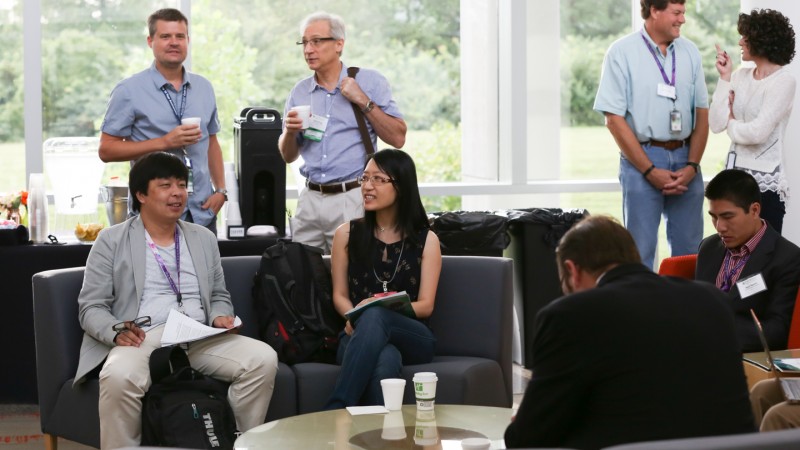About 320 researchers attended this year’s annual neutron scattering user meeting, held August 1–2 at Oak Ridge National Laboratory’s (ORNL’s) Spallation Neutron Source and High Flux Isotope Reactor and cohosted by the lab’s Center for Nanophase Materials Sciences (CNMS). The jointly held event focused on strengthening partnerships and improving discovery between the nanoscience and neutron scattering communities.
The event was organized by the SNS-HFIR User Group (SHUG) Executive Committee. SHUG is responsible for identifying key opportunities for improving the user program for ORNL’s two neutron scattering facilities.
“This was a marvelous opportunity to get people from the nanocenter and the neutron directorate together to see what the common areas of interest are and to acquaint them with what each of the centers offers that they might not have been aware of before,” said Jim Rhyne, program manager for the US Department of Energy’s neutron and x-ray scattering facilities.
For instance, he noted, CNMS is well prepared to develop polymer materials and do bulk characterization of them. In turn, neutrons provide complementary measurements such as reflectivity and small angle scattering. Together, they can tell us a lot, said Rhyne.
“There’s a lot of potential overlap between SNS, HFIR, and CNMS,” said Kate Ross, chair of SHUG’s executive committee. “For example, users can write joint proposals involving materials synthesis at CNMS, then use those samples at SNS or HFIR. Not a lot of people know about that. Hopefully researchers came away with potential collaboration ideas to do work at the other facility that they don’t normally use.”
Activities during the meeting included a poster session, beamline awards ceremony, and series of plenary sessions. Workshops and tutorials—targeting either the nanoscience or neutron scattering users or both—were held before and after the 2-day meeting.
“The future of these user facilities relies on bringing in new users. In that vein, I think the most impressive thing is the number of young scientists that attended the meeting,” said Rhyne. “Their level of enthusiasm was really amazing. After attending a number of their talks and looking at their posters, I must say the future looks bright.”
During the SHUG town hall meeting, ORNL instrument scientists Valeria Lauter and Ken Littrell were awarded the SHUG Award for Excellence in Beamline Science for their respective work on the Magnetism Reflectometer, SNS beamline 4A, and GP-SANS, HFIR beamline CG-2. The awards are based on nominations from the user community for outstanding user support from experiment preparation, execution, and analysis to publication.
Winners of the poster presentation include
• First place: Mikhael Soliman, University of Central Florida—Tracking the Uptake and Translocation of Zinc-Based Treatments Designed to Combat Citrus Greening Disease
• Second place: Wesley Surta, Oregon State University—Linking the Mechanisms of Na-Ion Binding to the Structure of Amorphous Hard Carbon
• Third place: Akinola Oyedele, University of Tennessee—Palladium Diselenide, a New 2D Semiconductor with Tunable Bandgaps and High Mobility for Electronics
• Honorable mention: Chance Brown, University of Tennessee—ToF-SIMS Investigation of Tip-Surface Chemical Interactions in Atomic Force Microscopy on a Combined AFM/ToF-SIMS Platform
• Honorable mention: Briana Lee, University of Central Florida—Nanoscale Investigation of Biophyicochemical Responses to Multivalent Nanoparticle Treatment on Xanthomonas Perforans
• Honorable mention: Gavin Hester, Colorado State University—Yb2Si2O7 Understanding Magnetic Correlations in a Novel Honeycomb Structure
CNMS, SNS, and HFIR are national user facilities supported by the DOE Office of Science, the single largest supporter of basic research in the United States, working to address some of the most pressing challenges of our time. For more information, please visit science.energy.gov.—by Jeremy Rumsey





